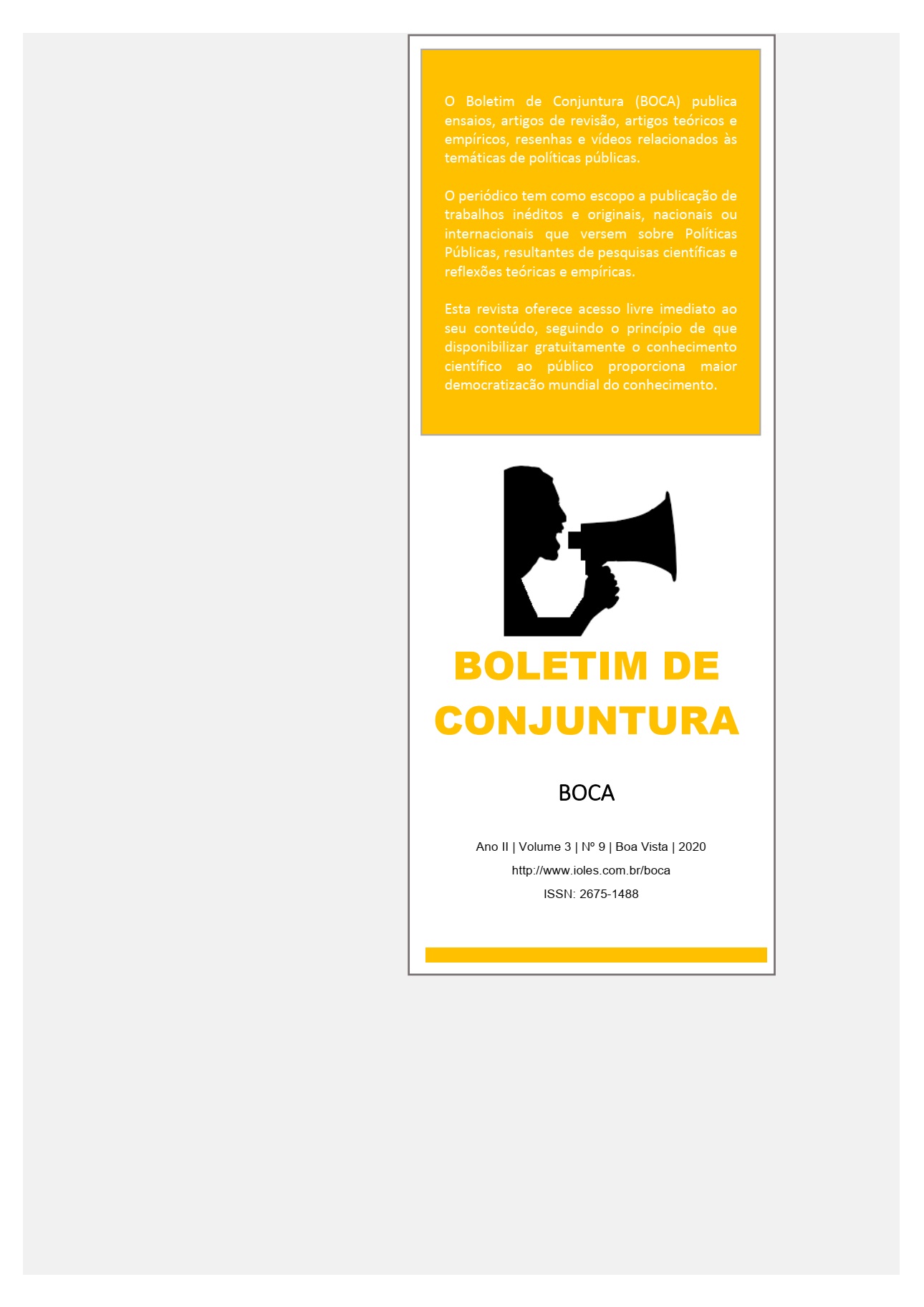ALIMENTAÇÃO SAUDÁVEL E EXERCÍCIOS FÍSICOS EM MEIO À PANDEMIA DA COVID-19
Contenido principal del artículo
Resumen
O presente estudo tem como objetivo analisar da importância de uma alimentação saudável e a prática de exercícios físicos em meio a pandemia da COVID-19, buscando ressaltar os cuidados e os seus benefícios para promoção da saúde. Através de uma revisão bibliográfica fundamentada em trabalhos acadêmicos adequados ao recorde temático nos bancos de dados Google Acadêmico e Scielo. As informações utilizadas basearam-se nos conhecimentos já consolidados na literatura sobre nutrição e exercícios físicos e em documentos científicos e oficiais até então divulgados. Verificou-se, portanto a importância deste assunto, visto que a alimentação é uma ciência que perpassa pela maioria das vertentes em saúde, além de entender que uma alimentação equilibrada que oferte nutrientes importantes ao bom funcionamento do organismo poderá potencializar nosso sistema imunológico para combater corpos estranhos, destacando também de fundamental importância a manutenção e/ou o aumento dos níveis de atividade na atual pandemia, desde quando todos os protocolos de biossegurança determinados pelas autoridades sanitárias sejam seguidos.
Detalles del artículo

Esta obra está bajo una licencia internacional Creative Commons Atribución 4.0.
Copyright (c). Boletim de Coyuntura (BOCA)
Este obra está bajo una licencia de Creative Commons Reconocimiento 4.0 Internacional.
Citas
ABARCA-GÓMEZ, L. “Worldwide trends in body-mass index, underweight, overweight, and obesity from 1975 to 2016: a pooled analysis of 2416 population-based measurement studies in 128· 9 million children, adolescents, and adults”. The Lancet, vol. 390, n. 10113, 2017.
ALECRIM, J. V. C. “Políticas públicas de esporte e lazer na promoção da saúde e covid-19: o que devemos aprender para o futuro”. Boletim de Conjuntura (BOCA), vol. 2, n. 5, 2020.
BARTRINA, J. A.; SERRA-MAJEM, L.; PEREZ-RODRIGO, C.; RIBAS-BARBA, L.; DELGADO RUBIO, A. “Nutrition risk in the child and adolescent population of the Basque country: the enKid Study”. British journal of nutrition, vol. 96, n. S1, 2006.
BRASIL. Ministério da Saúde. Guia Alimentar Para a População Brasileira. Brasília: Ministério da Saúde, 2014. Disponível em . Acesso em: 16/07/2020.
CARR, A, C.; MAGGINI, S. “Vitamin C and immune function”. Nutrients, vol. 9, n. 11, 2017.
CFN - Conselho Federal de Nutricionistas. “Nota Oficial: Orientações à população e para os nutricionistas sobre o novo coronavírus”. Portal Eletrônico do CFN [2020]. Disponível em . Acesso em: 16/07/2020.
CHEN, P.; MAO, L.; NASSIS, G. P.; HARNER, P.; AINSWORTH, B. E.; LI, F. “Coronavirus disease (COVID-19): the need to maintain regular physical activity while taking precautions”. Journal of Sport Health Science, vol. 9, n. 2, 2020.
DIAMOND, A. “Close interrelation of motor development and cognitive development and of the cerebellum and prefrontal cortex”. Child Development, vol. 71, n. 1, 2000.
GASMI, A.; NOOR, S.; TIPPAIROTE, T.; DADAR, M.; MENZEL, A.; BJORKLUND, G. “Individual risk management strategy and potential therapeutic options for the COVID-19 pandemic”. Clinical Immunology, vol. 215, n. 108409, 2020.
HALL, G.; LADDU, D. R.; PHILLIPS, S. A.; LAVIE, C. J.; ARENA, R. A. “Tale of two pandemics: how will COVID-19 and global trends in physical inactivity and sedentary behavior affect one another?”. Progress Cardiovascular Diseases, vol. 63, April, 2020.
JIMÉNEZ–PAVÓN, D.; CARBONELL-BAEZA, A.; LAVIE, C. J. “Physical exercise as therapy to fight against the mental and physical consequences of COVID-19 quarantine: Special focus in older people published online a head of print”. Journal of Physical Activity and Health, vol. 63, n. 3, 2020.
JOY, L. “Staying Active During COVID-19”. EIM Blog [03/17/2020]. Disponível em: <https://www.exerciseismedicine.org/support_page.php/stories/?b=892>. Acesso em: 17/08/2020.
KRINSKI, K. et al. “Efeitos do exercício físico no sistema imunológico”. Revista Brasileira de Medicina, vol. 67, n 7, 2010.
LADDU, D. R.; LAVIE, C. J.; PHILLIPS, S. A.; ARENA, R. “Physical activity for immunity protection: inoculating populations with healthy living medicine in preparation for the next pandemic”. Progress Cardiovascular Diseases, vol. 63, n. 2, 2020.
LASSELIN, J.; ALVAREZ-SALAS, E.; GRIGOLEIT, J. S. “Well-being and immune response: a multi-system perspective”. Current Opinion in Pharmacology, vol. 29, August, 2016.
LI, X. et al. “Clinical characteristics of 25 death cases with COVID-19: a retrospective review of medical records in a single medical center, Wuhan, China”. International Journal of Infectious Diseases, vol. 94, 2020.
LUZI, L.; RADAELLI, M. G. “Influenza and obesity: its odd relationship and the lessons for COVID19 pandemic”. Acta Diabetologica, vol. 57, n. 5, 2020.
MADDEN, D. J. et al. “Adult age differences in functional connectivity during executive control”. Neurolmage, vol. 52, n. 2, 2010.
MAGGINI, S.; PIERRE, A.; CALDER, P. C. “Immune function and micronutrient requirements change over the life course”. Nutrients, vol. 10, n. 10, 2018.
MARANHÃO, R. A.; SENHORAS, E. M. “Pacote econômico governamental e o papel do BNDES na guerra contra o novo coronavírus”. Boletim de Conjuntura (BOCA), vol. 2, n. 4, 2020.
OPAS - Organização Pan-Americana da Saúde. “Folha informativa – COVID-19”. Portal Eletrônico da OPAS [2020]. Disponível em . Acesso em: 02/07/2020.
PITANGA, F. J. G.; BECK, C. C.; PITANGA, C. P. S. “Should physical activity be considered essential activity during the covid-19 pandemic?” International Journal of Cardiovascular Sciences, vol. 33, n. 4, 2020.
SENHORAS, E. M. “A pandemia do novo coronavírus no contexto da cultura pop zumbi”. Boletim de Conjuntura (BOCA), vol. 1, n. 3, 2020.
SIMONNET, A.; CHETBOUN, M.; POISY, J.; RAVERDY, V.; NOULETTE, J.; DUHAMEL, A. “High prevalence of obesity in severe acute respiratory syndrome coronavirus-2 (SARS-CoV-2) requiring invasive mechanical ventilation”. Obesity, vol. 28, n. 7, 2020.


